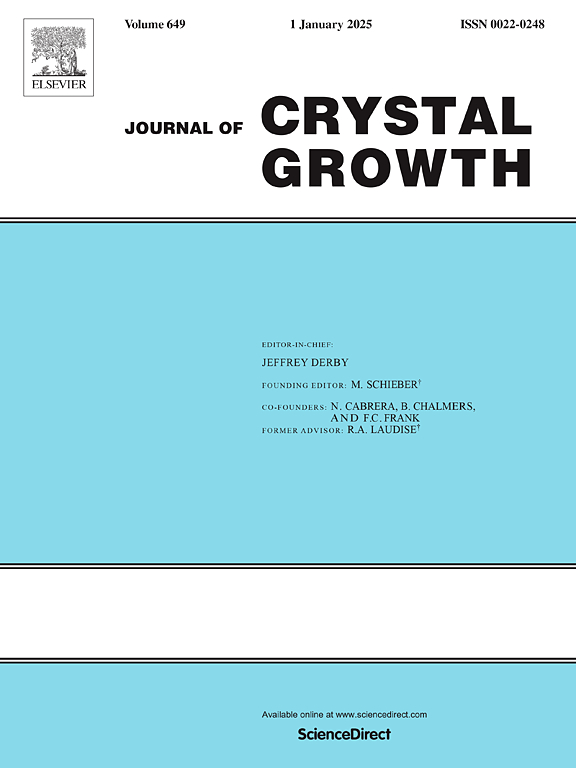Numerical simulation of flow and mass transport in KDP crystal growth using solution alternate jetting method
IF 1.7
4区 材料科学
Q3 CRYSTALLOGRAPHY
引用次数: 0
Abstract
In response to the limitations of some previous crystal growth method, which cannot generate ‘back-and-forth shear flow’ in rotating-crystal method and the partial realization of ‘back-and-forth shear flow’ in the crystal two-dimensional and three-dimensional motion methods, a novel KDP crystal growth method, named solution alternate jetting method, was proposed. This method can achieve complete coverage of crystal faces with ‘back-and-forth shear flow’. Numerical simulation results indicate that solution alternate jetting method outperforms rotating-crystal growth method and crystal two-dimensional and three-dimensional motion methods in terms of time-averaged supersaturation and its standard deviation on crystal faces. The jet velocity has a significant impact on the magnitude and distribution of time-averaged supersaturation on crystal faces. Other operating conditions, including the vertical distances from the nozzle outlet to the crystal surface, alternate jetting cycle, nozzle spray angle, and special motion velocity, have a relatively minor impact. Crystals grown with less than 50% ‘back-and-forth shear flow’ in the crystal two-dimensional and three-dimensional motion methods had significantly improved quality compared to rotating-crystal growth method. Therefore, the solution alternate jetting method, capable of achieving the ideal ‘back-and-forth shear flow’, undoubtedly holds promising application prospects.
利用溶液交替喷射法对 KDP 晶体生长过程中的流动和质量传输进行数值模拟
针对以往一些晶体生长方法在旋转晶体法中无法产生 "前后剪切流 "以及晶体二维和三维运动法中部分实现 "前后剪切流 "的局限性,提出了一种新型 KDP 晶体生长方法,即溶液交替喷射法。这种方法可以实现 "前后剪切流 "对晶体面的完全覆盖。数值模拟结果表明,就晶体面上的时间平均过饱和度及其标准偏差而言,溶液交替喷射法优于旋转晶体生长法以及晶体二维和三维运动法。喷射速度对晶体表面的时间平均过饱和度的大小和分布有显著影响。其他操作条件,包括喷嘴出口到晶体表面的垂直距离、交替喷射周期、喷嘴喷射角度和特殊运动速度,影响相对较小。与旋转晶体生长法相比,晶体二维和三维运动法中 "前后剪切流 "少于 50%的晶体生长质量明显提高。因此,能够实现理想 "前后剪切流 "的溶液交替喷射法无疑具有广阔的应用前景。
本文章由计算机程序翻译,如有差异,请以英文原文为准。
求助全文
约1分钟内获得全文
求助全文
来源期刊

Journal of Crystal Growth
化学-晶体学
CiteScore
3.60
自引率
11.10%
发文量
373
审稿时长
65 days
期刊介绍:
The journal offers a common reference and publication source for workers engaged in research on the experimental and theoretical aspects of crystal growth and its applications, e.g. in devices. Experimental and theoretical contributions are published in the following fields: theory of nucleation and growth, molecular kinetics and transport phenomena, crystallization in viscous media such as polymers and glasses; crystal growth of metals, minerals, semiconductors, superconductors, magnetics, inorganic, organic and biological substances in bulk or as thin films; molecular beam epitaxy, chemical vapor deposition, growth of III-V and II-VI and other semiconductors; characterization of single crystals by physical and chemical methods; apparatus, instrumentation and techniques for crystal growth, and purification methods; multilayer heterostructures and their characterisation with an emphasis on crystal growth and epitaxial aspects of electronic materials. A special feature of the journal is the periodic inclusion of proceedings of symposia and conferences on relevant aspects of crystal growth.
 求助内容:
求助内容: 应助结果提醒方式:
应助结果提醒方式:


